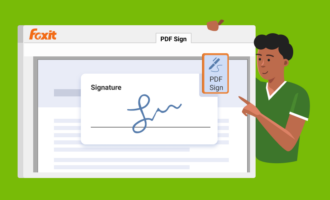The act of signing our name in longhand to seal a contract or authenticate a document, such as a letter or report, has had legal significance for nearly as long as there has been written language, even before paper. The first known signature in human history was that of an otherwise forgotten Sumarian scribe, Gar Ama, who etched his name on a clay tablet in 3100 BCE.
Since paper documents are well on their way to becoming the clay tablets of the 21st century, you may be wondering if an electronic signature can be legally binding. The answer is yes, and the implications for business are significant.
E-signatures are the biggest development in how people agree to contracts since 1677, when the English Parliament made signatures a legally required feature of a valid, written contract in the Statute of Frauds Act.
E-signatures have been binding in the United States since President Bill Clinton e-signed (after first signing the written legislation the traditional way) the Electronic Signatures in Global and National Commerce (ESIGN) Act in 2000. The law, along with the Uniform Electronic Transactions Act, which was passed by every state in the U.S. in some version, has made electronic contracts, when legally executed, legally enforceable. Similar legislation exists in the European Union.
Elements of a valid e-contract
There are a few basic requirements for making electronic signatures legally enforceable, but once the requirements are met, electronically signed contracts can be enforced the same way as a printed contract signed with a pen.

In the United States, you can use an electronic signature for signing contracts. Courts allow you to present an electronic signature as evidence in a court case. Moreover, a document, record, or agreement can’t be denied just because it’s electronic.
However, to be legally binding, e-signatures must
- Demonstrate that the signer had definite intent to sign; for example, provide a clear option not to sign.
- Prove the signer consented to conduct their business electronically. Most electronic signatures require that you give consent before signing. (Some might provide the option to complete the form on paper.)
- Clearly attribute the signature. This could include an email trail, IP address, or time stamp. Some providers have a two-step identification system for signers. Although this creates an extra step for the signer, it creates a higher standard of attribution.
- Associate, or directly connect, the signature with the document being signed.
Send my document for signature
File type is not allowed.
Maximum file size limit exceeded. (5MB)
Something went wrong.
When you satisfy these requirements, you’re on your way to collecting legally binding electronic signatures. Remember that the above conditions might already be incorporated into an e-signature provider’s solution.
Consumer contracts have particular requirements, the most important of which is that the consumer must give consent to do business electronically by affirmatively opting in to the electronic signature process. To meet this requirement, you must include language in the contract stipulating that the consumer agrees to the use of electronic signatures, or by requiring the signer to check a box.
Some key court cases have affirmed the validity of e-signatures. See, for example, cases listed here. If you think your industry might have additional requirements, consult your attorney for advice on your specific case.
So if electronic signatures are legal, why aren’t they used in every situation?
Not all documents can be e-signed
In some cases, an electronic signature may not be accepted. Multiple witnesses or a notary are sometimes required, nullifying the convenience of electronic signatures delivered remotely. Another reason for not using e-signatures is if signees aren’t computer-literate.
There are also several important, and often personal, types of documents that still must be signed by hand. In general, this includes any document that must bear a raised notary seal, such as wills, trusts, powers of attorney, birth and death certificates, and legal notices such for an eviction, repossession, or foreclosure. In the U.S., only a few states allow some documents to be notarized electronically.
Outside of such special cases, e-signatures are legally enforceable, which has made them an important component of online commerce.
Use cases for e-signatures
All types of industries need contracts, agreements, and forms. You use them to start a company, run an employee background check, and hire subcontractors on a construction site. As a result, e-signatures are seemingly everywhere. E-signatures can work in almost any industry, government, or legal application.

Here are a few cases where electronic signatures have proven successful.
- Healthcare. For a hospital department, reducing the time it takes to get signatures from doctors, patients, and insurers is vital. In one radiology department, the time needed to get signatures for abdominal examinations dropped from 11 to three days. The time needed for signatures related to chest examinations dropped from 10 to five days. By using e-signatures to shorten or skip steps in employees’ workflow, productivity rose.
Without e-signatures, the future functions of healthcare — like long-distance treatment, virtual hospitals, and medical e-commerce — cannot be easily achieved. - Labor unions. Electronic signatures help traditional organizations get more organized. The same holds true for unions. With changes in policy regarding e-signatures, unions can gather employee information much faster. E-signatures also link better with online social networks, helping spread the union’s reach. With e-signatures, unions can organize privately and with higher participation and impact.
- Small to medium enterprises. When you’re a small fish competing with whales, it helps if you can swim fast and adapt quickly to changing conditions. Agility in commerce is highly valued and for good reason.
Speed can spread to other areas, such as faster sales cycles and product iteration, and more responsive customer service. E-signatures enable leaders to buy into agility and sign contracts minutes after they’re drafted. - Government. Petitions changed forever after the introduction of electronic signatures. Consider a public petition to cancel the U.K.’s Brexit deadline. It collected millions of signatures in a few months. Online petitions reach a wider audience and spread faster than their paper equivalents.
- Family law. Electronic wills, one of the last frontiers for e-signatures, have been legal in Nevada since 2001. Arizona and Indiana have followed suit. Most other states still require will creators to sign before two witnesses who also sign the document.
- Disability services. The move to online information allows consumers with visual challenges to manage their business better. Handheld devices and desktop computers can enlarge document font size. Some consumers may opt to use a text-reader program to read text out loud.
- Seniors. It’s a myth that older citizens don’t use online services, like e-signatures. About 42 percent of adults aged 65 and older have smartphones. That number is up from 18 percent in 2013. Internet use and home broadband adoption among this group have also risen. Today, 67 percent of seniors use the internet — a 55 percent increase in 20 years.
- Finance. There are many different ways to use an electronic signature in finance. In the United States, credit and loan forms frequently allow e-signatures. Digital mortgages are becoming more commonplace. After February 2018, most states adopted national standards for online notarization.
According to a Federal Reserve survey, if faced with an unexpected expense of $400, four in 10 adults would either not be able to cover it or would cover it by selling something or borrowing money. One option for covering such an expense is a signature loan, a popular method for borrowing money. The process of securing a signature loan can be improved by using e-signatures.
If you want to start using e-signatures for your agreements, try Jotform’s latest product, Jotform Sign, which enables you to easily create legally binding documents and get them signed.

AS ALWAYS, CONSULT AN ATTORNEY BEFORE RELYING ON ANY FORM CONTRACT OR CONTRACT TEMPLATE. THE CONTENT ABOVE IS FOR INFORMATIONAL PURPOSES ONLY.











































Send Comment:
1 Comments:
More than a year ago
I hired a company to fix my home sewage system. When presented with a contract to sign from a tablet, I told the tech I couldn't see the screen. I said with my wife as a witness "My reading glasses are broken and I don't have new ones yet." He read the contract to me. Upon hearing that it said I would be held responsible for any mistakes he made on the job, I said "No. I won't sign that. I'm not signing anything that says you won't have to come back and fix any mistakes you made." He took it back and acted like he was changing things on it, said "I fixed it. It doesn't say that anymore.", and I signed. Over the course of a couple of days he had me sign five different contracts. He told me that the contracts would be emailed to me. This was October 8th. On November 1st, I hadn't received a single one until I went to his place of business in person to request copies. I was told once again, this time by the office manager, that contracts get emailed to customers. She questioned too why I didn't receive any copies via email. So she handed me a hard copy. By large majority, the things that were stated were not things that I would have consented to. I was sick that week with numerous health problems of which I made them entirely aware. Bottom line, do I have a legal avenue for recourse?